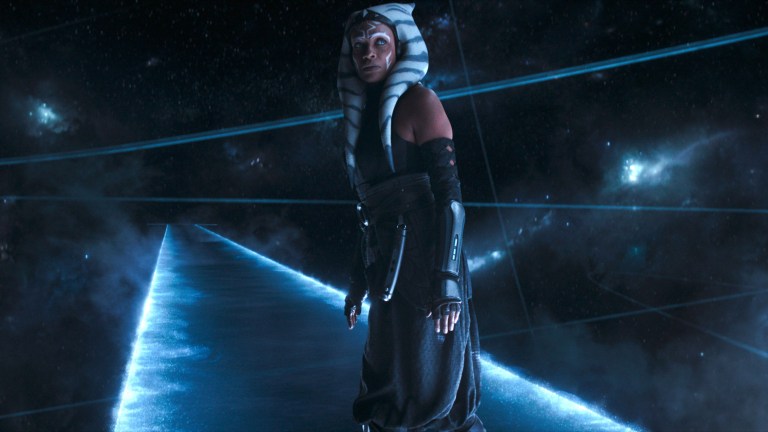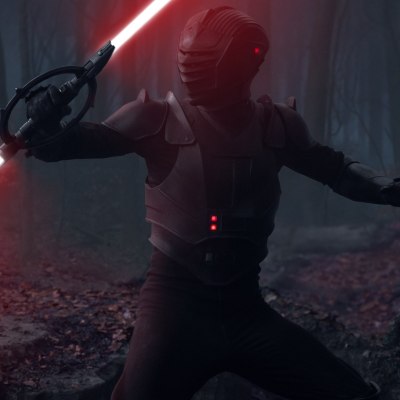Star Wars: Ahsoka Episode 5 Review – Shadow Warrior
Ahsoka episode 5 is a nostalgic treat for fans of the Star Wars Prequel Trilogy and The Clone Wars.

This Star Wars: Ahsoka article contains spoilers.
Ahsoka Episode 5
Welp, it looks like we’re going to have to wait another week (at least) until we see the long awaited, endlessly teased return of Ezra Bridger and Grand Admiral Thrawn. Ahsoka’s fifth episode, “Shadow Warrior,” taking place almost entirely on Seatos, offering nary a glimpse of wherever Sabine and Morgan’s crew zipped off to, may be more than a little upsetting for some.
But beyond contributing to the agonizing anticipation of what we’ll find beyond “the jump,” in so many ways this episode is one of the most artful, cinematic, polished of the series so far. It’s written tastefully, and some of the most profound messages are conveyed with touches as understated as a slouch in posture or a knowing smile. And the ending leaves us on an uplifting note that invokes what made the Original Trilogy so brilliant in the first place.
Hera and Captain Teva’s involvement in the storyline thus far makes some sense…it just isn’t all that compelling. Their fending off of the Republic’s meddling throughout the episode adds a bit of suspense to Ahsoka’s Purrgil whispering in the third act, and Paul Sun-Hyung Lee’s Carson continues to develop as a more likable side character with each appearance. Still, Hera just feels generally detached from the crux of the story, perpetually removed from all of the real action.
At least we get to watch Hera and Jacen (Evan Whitten) spend more time together, and their interactions are really sweet. Jacen’s unwavering faith and connection to the Force saves Ahsoka from her watery tomb, and his impending development into a young Jedi is one of the more exciting prospects for the show down the line. It might be nice for him to be presented as more of a side protagonist than a purely supporting character at this point, but perhaps the timing isn’t right for that quite yet.
One of the most potent moments in the episode is a small one: Huyang holds Sabine’s helmet, his head hung low, and says with heartache in his voice, “I told them to stay together. They never listen…They never listen.” And later, when he tells Hera, “You do things your way because you care. This is why people like you,” it cements him as the unlikely heart and soul of the show. What Dave showrunner Filoni is doing with Huyang is consistently phenomenal.
What makes Ahsoka’s final lesson with Anakin so special is how poetic it is. He presents her with a choice: Live or die. Their conversation is largely, well, cryptic. But that’s pretty on-brand for Star Wars, isn’t it? Yoda and Old Luke speak in riddles all the time, so this feels like familiar territory. Ahsoka plunging into a tortured memory of the Clone Wars is appropriate for the story being told—Anakin’s teaching her “how to be a soldier” after all—though visually, the giant lavender fog that envelops the scene only serves to highlight that the actors are running around a dirt-covered sound stage. Despite this, the ultimate message hits home: Ahsoka comes from a legacy of destruction, but she doesn’t have to be defined by it. She can choose to live and choose not to fight. The audience is challenged to infer much of Anakin’s messaging here, which is always preferable to incessant hand-holding.
But if what you really want is a bit of nostalgia from these scenes, we also get a cameo from Temuera Morrison as Commander Rex as he was during the Siege of Mandalore in The Clone Wars season 7! An earlier flashback also features young Ahsoka (played brilliantly by Ariana Greenblatt) fighting alongside an armored Anakin during what looks like the Battle of Ryloth. Seeing Hayden Christensen in full Clone Wars garb is definitely a treat for those who have dreamed of seeing designs from the cartoon jump to live action. And let’s not forget that the lesson eventually leads to Ahsoka finally donning Gandalf the White-inspired robes she wore at the end of Rebels. It’s clear Filoni is having a field day.
The actual sparring session between Ahsoka and Anakin in the World Between Worlds (?) isn’t particularly notable or unique, but it is cool to watch the two characters interact in live-action and to see Christensen pull off some of his lightsaber moves from the Prequels. The de-aging effects on Christensen are slightly distracting, and Ahsoka’s comment that he “looks the same” doesn’t help to veil the visual effects at play. On the other hand, the close-up shot of Ahsoka being submerged before she awakens in the depths of the Seatos ocean is one of the coolest images the show has conjured so far.
Another little moment that works really well comes after Ahsoka listens to the echo of Sabine’s conversation with Baylan. There’s a shot of her looking at Sabine’s helmet, and you can almost hear Anakin’s words from earlier in the episode about the complexities of being a teacher bouncing around in her head. She’ll do whatever it takes to save her Padawan, including something as wild as having a chat with a pod of Purrgil.
The vision of the mother Purrgil emerging from the thick clouds to come face to face with Ahsoka is, in a word, majestic. It’s just ravishing stuff. A fine example of premium CGI work that actually has an impact on the storytelling. These creatures have served as a symbol of hope and mystery, and for Ahsoka to hitch a ride to who-knows-where inside one of their gigantic maws is peak sci-fi fantasy goodness.
Once again, while this episode was light on action, there are a lot of seemingly minor details that actually add a world of depth to the story. As Ahsoka prepares to take the biggest risk of her life traveling to a distant galaxy to save her friends, there isn’t a trace of fear or trepidation on her face. Instead, she wears a warm smile. It’s the same smile Obi-Wan wore in A New Hope, and the same smile Anakin gave her when he said, “There’s hope for you yet.” She’s found herself again, and she has faith that everything will be okay. It’s this allusion to faith and spiritualism that made the Original Trilogy so fascinating and thematically rich, and it’s impressive to see Filoni wield those ideas in such similar fashion all these years later.


